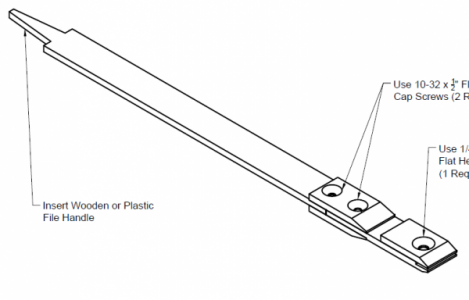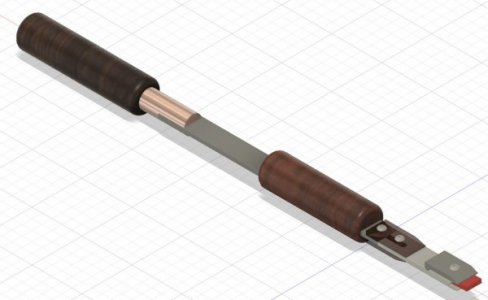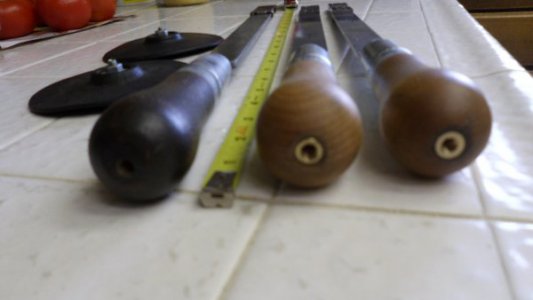I'm monkeying around with making a scraper to repair the cross-slide on the 1440 and would appreciate some input from those that use them.
I'm attempting to do this with materials that I have on-hand. The lathe crapped out at very a inconvenient time.
I had to take a pass on a decent bit of side work because with the stick-slip, I messed up the first three pieces. So the budget is hurting.
Richard sent me a copy of Keith Rucker's design. (Thanks Richard!)
I have a couple of questions about the design.
I've got a few pieces of 3/4" Sqr. carbide inserts that I'm trying to make do with. I realize that they are really not wide enough, however it's all I've come up with.
On Keith's design on the insert extension piece, the flat on the end is at 2° positive.
Does anyone know why? I'm wondering if it can be 'straight'.
 ..........
..........
Here's my first take on it using the 3/4" insert.
I'm making a couple of needed ergonomic / handling modifications to it.
I made up a mock-up out of a file and then played around with it trying to mimic the way I've seen people handle them in videos.
A problem/difficulty has cropped up from this, with my left hand tendons messed up from some medicine, gripping the scraper becomes uncomfortable after a bit.
With this first take, I've made a change on the handle end so that I can try out different size handles if needed. They will be screw on.
My Left-Handed/Right-Handed -ness is odd. I write left handed but do a number of other things right handed, it just depends.
I haven't figured out which way I'll hold a scraper yet.
If I'm holding the end with my left hand, 1.5"-2" DIA. feels best and lessens the discomfort.

Then I've also added a 'Grip' handle for holding the shank left handed.

Thanks,
_Dan
I'm attempting to do this with materials that I have on-hand. The lathe crapped out at very a inconvenient time.
I had to take a pass on a decent bit of side work because with the stick-slip, I messed up the first three pieces. So the budget is hurting.
Richard sent me a copy of Keith Rucker's design. (Thanks Richard!)
I have a couple of questions about the design.
I've got a few pieces of 3/4" Sqr. carbide inserts that I'm trying to make do with. I realize that they are really not wide enough, however it's all I've come up with.
On Keith's design on the insert extension piece, the flat on the end is at 2° positive.
Does anyone know why? I'm wondering if it can be 'straight'.
 ..........
..........
Here's my first take on it using the 3/4" insert.
I'm making a couple of needed ergonomic / handling modifications to it.
I made up a mock-up out of a file and then played around with it trying to mimic the way I've seen people handle them in videos.
A problem/difficulty has cropped up from this, with my left hand tendons messed up from some medicine, gripping the scraper becomes uncomfortable after a bit.
With this first take, I've made a change on the handle end so that I can try out different size handles if needed. They will be screw on.
My Left-Handed/Right-Handed -ness is odd. I write left handed but do a number of other things right handed, it just depends.
I haven't figured out which way I'll hold a scraper yet.
If I'm holding the end with my left hand, 1.5"-2" DIA. feels best and lessens the discomfort.

Then I've also added a 'Grip' handle for holding the shank left handed.

Thanks,
_Dan



 )
)